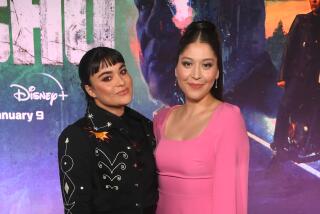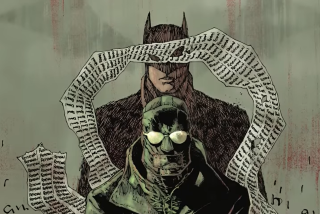Shazam or Sham? : Exhibit Underscores Comics’ Portrayal of Minorities
- Share via
A heated exchange on a comic book cover between Superman and Black Lightning mesmerized a visitor to the California Museum of Science and Industry in Los Angeles.
DC Comics’ Man of Steel offers the African-American renegade super-hero, Lightning, a handshake and a place in the Anglo-dominated “Justice League of America.”
The gesture was made in a 1973 issue, when affirmative action had reached even the Justice League.
“We want you on the team,” Superman says.
Lightning’s response: “With that jive bunch of turkeys in the JLA? Forget it!”
The cover appears in “Ethnic Images in the Comics,” an exhibit on display until Dec. 3 at the museum in Exposition Park.
The exhibit, produced by the Anti-Defamation League of B’nai B’rith and the Balch Institute of Ethnic Studies, is an unapologetic look at how minorities have been portrayed by cartoonists in the United States.
“Images like these made you feel confused,” said Oscar Garcia, 28, as he led his 6-year-old son, Christopher, through the exhibit earlier this week. “There we were, just children at the time, all of us trying to be like Superman.”
Through the comics, Garcia’s memory drifted back to the early ‘70s. He remembered growing up in East Los Angeles, not yet 10 years old, when Los Angeles County sheriff’s deputies in riot gear fired tear gas canisters to break up an anti-Vietnam War rally, and one projectile crashed through the skull of Latino journalist Ruben Salazar.
Garcia remembered how some of his neighbors charged that the officers incited a series of violent confrontations in East Los Angeles. He remembered rioting and the subsequent Latino empowerment movement.
“Hispanic people were struggling for our identity; the black super-hero character was doing the same,” he said. “But back then we would have thought that the black guy was the bad guy, because he was going against Superman. The picture on the cover makes him look like an outlaw.”
Garcia said that Lightning’s dilemma was similar for most minorities--whether to remain outsiders or to try to assimilate into white society.
Looking at the comic book cover now, “the black character’s reaction is understandable,” Garcia said. “He doesn’t want to become part of the system. Like a lot of us, he wasn’t understood.”
In between explanations to his son, Garcia said that the myriad of images covering the walls of the 3,000-square-foot exhibit room brought back powerful memories of a turbulent time.
The reason people are drawn to comics, said David Lehrer, regional director of the Anti-Defamation League, is because they provide an index of popular sentiment and culture.
Begun in the 1890s as a “gimmick” to boost newspaper circulation, the comic strip pages have become perhaps the most widely read portion of modern newspapers, Lehrer said. The comic book format spawned in the late 1930s attracted even more readers.
“They are not high literature, or esoteric poetry,” he said. “Comics are, though, what a lot of people are reading and thinking about.”
The exhibit measures the effect that changing immigration patterns, American foreign policy and civil rights consciousness had on ethnic portrayals--including Italians as “underworld thugs,” African-Americans as “jungle-dwelling savages” and Asians as “sinister Orientals.”
America used its “super-heroes to play out the myth of its own superiority,” reads an exhibit panel written by the Balch Institute. And in the pages of the comics, “the idea of equality could be played out without disturbing contradictions,” the panel reads.
Non-Anglo people--including Asians, African-Americans, Middle Easterners and Native Americans--who cannot assimilate racially with whites have for the most part remained in secondary roles as valets or foils to the Anglo-American lead characters, another panel reads.
And while there have been improvements in portrayals, the advances toward equality in the comics have been incremental.
“Except for a few black faces there are no distinctly ethnic figures in comics today,” the audio narrative to the exhibit concludes.
“Ethnic Images” has drawn a modest audience since it opened on Oct. 6, said Evan Nossofs, spokesman for the museum.
“It is not our most popular, but people who do go through usually stay longer,” he said. “Visitors tend to go around and read all the copy. There’s a lot to take in.”
More to Read
Sign up for Essential California
The most important California stories and recommendations in your inbox every morning.
You may occasionally receive promotional content from the Los Angeles Times.













